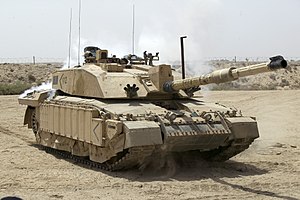| FV4034 Challenger 2 | |
|---|---|
 A Challenger 2 tank patrolling outside Basra, Iraq, during Operation Telic, 2003 | |
| Type | Main battle tank |
| Place of origin | United Kingdom |
| Service history | |
| In service | 1998–present |
| Used by | |
| Wars | |
| Production history | |
| Designed | 1986–1993 |
| Manufacturer | |
| Unit cost | £4,217,000 (FY 1999)[1] |
| Produced |
|
| No. built | about 447 |
| Specifications | |
| Mass |
|
| Length |
|
| Width |
|
| Height | 2.49 m (8 ft 2 in) |
| Crew | 4 (commander, gunner, loader–operator, driver) |
| Armour | Chobham / Dorchester Level 2 (classified) |
Main armament | L30A1 120 mm rifled gun with 47 rounds[3][4] |
Secondary armament |
|
| Engine | Perkins CV12-6A V12 diesel 26.1 L (1,590 cu in) 1,200 bhp (890 kW) |
| Power/weight |
|
| Transmission | David Brown TN54E epicyclic transmission (6 fwd., 2 rev.) |
| Suspension | Hydropneumatic |
| Ground clearance | 0.5 m (1 ft 8 in)[5] |
| Fuel capacity | 1,592 litres (350 imp gal; 421 US gal)[5] |
Operational range | |
| Maximum speed | |
The FV4034 Challenger 2 (MoD designation "CR2") is a third generation British main battle tank (MBT) in service with the armies of the United Kingdom, Oman, and Ukraine.[8][9]
It was designed by Vickers Defence Systems (now BAE Systems Land & Armaments) as a private venture in 1986, and was an extensive redesign of the company's earlier Challenger 1 tank.[10] The Ministry of Defence ordered a prototype in December 1988. The Challenger 2 has four crew members consisting of a commander, gunner, loader, and driver. The main armament is a L30A1 120-millimetre (4.7 in) rifled tank gun, an improved derivative of the L11 gun used on the Chieftain and Challenger 1.[11] Fifty rounds of ammunition are carried for the main armament, alongside 4,200 rounds of 7.62 mm ammunition for the tank's secondary weapons: a L94A1 EX-34 chain gun mounted coaxially, and a L37A2 (GPMG) machine gun. The turret and hull are protected with second generation Chobham armour, also known as Dorchester. Powered by a Perkins CV12-6A V12 diesel engine, the tank has a range of 550 kilometres (340 mi) and maximum road speed of 59 kilometres per hour (37 mph).[12]
The Challenger 2 eventually completely replaced the Challenger 1 in British service. In June 1991, the UK ordered 140 vehicles, followed by a further 268 in 1994; these were delivered between 1994 and 2002. The tank entered operational service with the British Army in 1998 and has since been used in Bosnia and Herzegovina, Kosovo and Iraq.[8] To date, three Challenger 2 tanks are confirmed to have been destroyed in operations; the first was by accidental friendly fire from another Challenger 2 in Basra in 2003,[13] and the two others were during the Russo-Ukrainian War, where the tanks were destroyed under Ukrainian control during the 2023 Ukrainian counteroffensive and Ukrainian incursion into Kursk.[note 1][14][15]
Challenger 2 tanks were also ordered by Oman in the 1990s with delivery of 38 vehicles being completed in 2001. A number of British Challenger 2 tanks were delivered to Ukraine in 2023.[16]
Since the Challenger 2 entered service in 1998, various upgrades have sought to improve its protection, mobility and lethality. This has culminated in an upgraded design, known as Challenger 3, which is set to gradually replace Challenger 2 from 2027.[17]
- ^ "Challenger 2". armedforces.co.uk. Archived from the original on 9 May 2008. Retrieved 16 January 2011.
- ^ Taylor, Dick (2018). Challenger 2 Main Battle Tank Owners' Workshop Manual: 1998 to Present. J H Haynes & Co Ltd. p. 181.
- ^ "Combat Vehicles". Archived from the original on 6 October 2014. Retrieved 4 September 2014.
- ^ "Challenger 2 Main Battle Tank". Archived from the original on 11 December 2005. Retrieved 24 December 2005.
- ^ a b c d Foss, Chris (2005). Jane's Armour and Artillery 2005–2006. Jane's Information Group. p. 143. ISBN 0-7106-2686-X.
- ^ Maginnis, Chris (6 July 2013), Tankfest 2013 Challenger 2 MBT (Ultra Modern Version), archived from the original on 13 April 2016, retrieved 27 November 2016 – via YouTube
- ^ "British Army Vehicles and Equipment" (PDF). Army.mod.uk. Archived from the original (PDF) on 19 November 2010. Retrieved 30 October 2014.
- ^ a b British Army. "Combat Vehicles". army.mod.uk. Archived from the original on 24 March 2021. Retrieved 11 April 2021.
- ^ Axe, David (30 March 2023). "Ukraine's Challenger 2 Tanks Could Counterattack Around Bakhmut". Forbes. Retrieved 2 April 2023.
- ^ "Products & Services Challenger 2". BAE Systems. 14 February 2008. Archived from the original on 21 June 2007. Retrieved 16 January 2011.
- ^ "Vickers Defence Systems Challenger 2 MBT". Archived from the original on 4 August 2004.
- ^ "Challenger 2 Main Battle Tank". army-technology.com. Archived from the original on 11 December 2005. Retrieved 24 December 2005.
- ^ Rory McCarthy (26 March 2003). "Friendly fire kills two UK tank crew". The Guardian. Archived from the original on 22 May 2018. Retrieved 21 May 2018.
- ^ Barnes, Joe; Vasilyeva, Nataliya (5 September 2023). "Watch: First British Challenger 2 tank destroyed in Ukraine advance". The Telegraph. ISSN 0307-1235. Retrieved 5 September 2023.
- ^ Sabbagh, Dan (5 September 2023). "British Challenger 2 tank destroyed in combat for first time, Ukraine footage shows". The Guardian. ISSN 0261-3077. Retrieved 5 September 2023.
- ^ Pitel, Laura (27 March 2023). "First German Leopard 2 tanks delivered to Ukraine". Financial Times. Retrieved 27 March 2023.
- ^ Wallace, Ben (March 2021). Defence in a Competitive Age (PDF). HM Stationery Office. p. 54. ISBN 978-1-5286-2462-6. Retrieved 22 March 2021.
Cite error: There are <ref group=note> tags on this page, but the references will not show without a {{reflist|group=note}} template (see the help page).